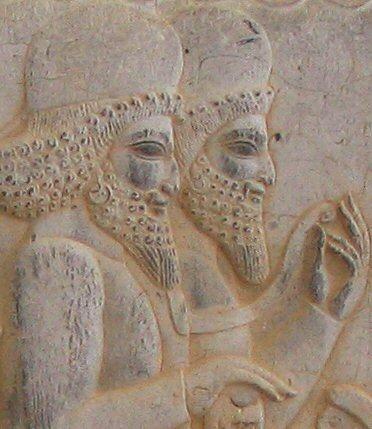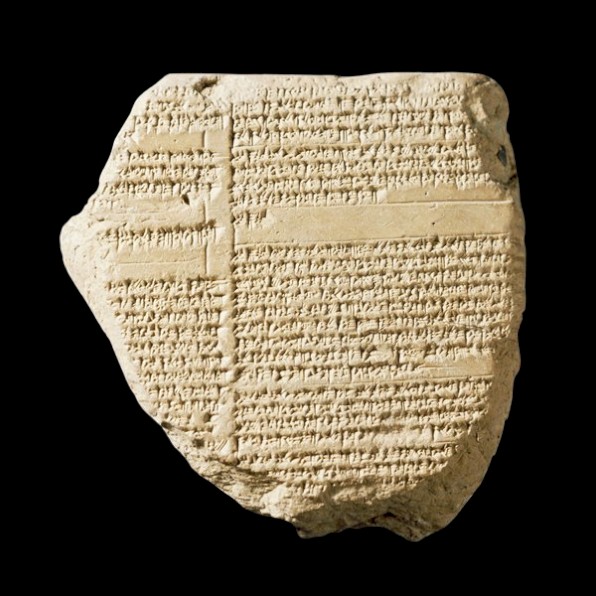Astyages

Most information on Astyages can be found in the second part of the first book of the Histories by Herodotus of Halicarnassus, who lived in the fifth century, hundred years after Astyages' reign. However, the Greek researcher is almost our only source, and it is inevitable to follow Herodotus' lead and trying to check him where possible.
There is no need to doubt Herodotus' statement that Astyages was the son of the Median king Cyaxares. We know from a cuneiform text that the latter was already king in 614, when he destroyed the Assyrian religious center Aššur. Cyaxares was still alive in the summer of 585, when - according to Herodotus - he signed a peace treaty with the Lydians, with whom he had been fighting for five years.note A diplomatic marriage was arranged to celebrate the treaty: Aryenis, a sister of the Lydian king Croesus, was married to the Median crown prince Astyages.
Aryenis was not Astyages' first wife. His daughter Mandane was married to the Persian king Cambyses before 576 BCE - when the future king Cyrus the Great was born - and Mandane must have been born before, say, 590. It seems inevitable to assume that Astyages had another wife.note (There is some doubt about the truth of the marriage between Mandane and Cambyses. According to Ctesias of Cnidus, their son Cyrus married to a daughter of Astyages. That would be his aunt, which is most unusual.)
There is another argument why Aryenis cannot have been Astyages' first wife. His father Cyaxares had started to reign before 614. If we assume that he had become king at the age of thirty - which is not improbable - and his son was born when he was twenty-five - which is possible -, we must assume that Astyages married Mandane at the age of at least thirty-four. In ancient society, this would have been very improbable.
The Babylonian historian Berossus (third century BCE) tells us that after the fall of Aššur in 614, an alliance between the Medes and the Babylonians was cemented by another royal wedding: the Babylonian crown prince Nebuchadnezzar married Amytis, the daughter of Astyages. This is impossible, because it would suggest that Astyages was almost hundred years old when he was dethroned.
It is unclear when Astyages was elected king of the Medes (if he was elected at all). Herodotus tells us that Astyages had reigned for thirty-five years when he was taken captive by the Persian king Cyrus.note From the cuneiform text that is known as the Chronicle of Nabonidus, we know that this happened in the sixth year of the Babylonian king Nabonidus, which is the period between 10 March 550 and 28 March 549 (a leap year with thirteen lunar months). Counting backwards, we arrive at 585/584 as the year of Astyages' accession. This is not impossible, although we must assume that Astyages' father Cyaxares was still alive in 585, when he concluded a peace treaty with the Lydians.
However, the regnal years of the Median kings mentioned by Herodotus are a bit suspect: the four kings reign exactly hundred and fifty years, in two pairs of each seventy-five years. It is obvious that we must be cautious, but up till now, there is nothing to contradict his statement that Astyages reigned from 585/584 to 550/549 and his father Cyaxares from 625/624 to 585/585. (Although it should be noted that there is one inscription that says that Astyages was dethroned in 554/553.)
According to Herodotus, Astyages had a dream about the son of his daughter Mandane and her husband Cambyses, Cyrus, which he took as an evil omen.note Therefore, Astyages ordered his courtier Harpagus to kill the young boy, but Harpagus secretly gave it to a herdsman, who was to do the dreadful deed. Fortunately, the herdsman and his wife decided not to kill the baby, but to accept him as their own son.
When the boy was ten years old, it became obvious that he was not a herdsman's son. His behavior was too noble, according to Herodotus. Astyages started to suspect what had happened when he interviewed the boy and noticed that his face resembled his own. He ordered Harpagus to explain what he had done with the baby, and when the courtier confessed that he had not killed Astyages' daughter's child, the king forced him to eat his own son. Cyrus received a favorable treatment and was allowed to go to his own parents, Cambyses and Mandane.
According to Herodotus, Harpagus was looking for an opportunity to avenge himself. When Cyrus had come of age, Harpagus managed to convince the young man that the Medes were ready to revolt against their king, who had become a despot. Cyrus organized a federation of ten Persian tribes and revolted, and Astyages "armed all the Medes, and blinded by divine providence he appointed Harpagus to be the leader of the army". Of course, Harpagus did not hesitate to switch allegiance. The united army of Medes and Persians marched to the Median capital and seized Astyages, who was kept captive by Cyrus.

The first part of Herodotus' story is, of course, an oriental fairy tale. However, the last part of it is confirmed by the Chronicle of Nabonidus, where we read that in the sixth year of the Babylonian king Nabonidus, king Astyages called up
his troops and marched against Cyrus, king of Anšan [i.e., Persia], in order to meet him in battle. The army of Astyages revolted against him and in fetters they delivered him to Cyrus. Cyrus marched against the country Ecbatana; the royal residence he seized; silver, gold, other valuables of the country Ecbatana he took as booty and brought to Anšan.
It is possible that the deepest cause of the rebellion of Harpagus was dissatisfaction with Astyages' policy. In the sixth century, the Iranian tribes became more and more settled, and their kings were no longer the first among equal tribal chiefs, but started to behave as real kings. When Astyages started to punish one of the other tribal chiefs, revolt was inevitable.
The fall of Astyages was not the end of the war, however, because Astyages' allies were prepared to help him. According to Herodotus, the
destruction of the kingdom of Astyages [...] and the increasing power of the Persians forced [the king of Lydia] Croesus to cut short the power of the Persians, if this were still possible, while it was too late.note
Most historians still state that in 547 BCE (although in fact it must have been later), Croesus launched an expedition against the Persians to avenge his brother-in-law. However, he was defeated; Cyrus added Lydia to his dominions.
The Greek historian Ctesias (c.400 BCE), as quoted by the Byzantine scholar Photius,note calls Astyages "Astuïgas", which is closer to the Babylonian rendering of his Iranian name Ištumegu. The variant "Astyages" means "sacker of cities" in Greek.